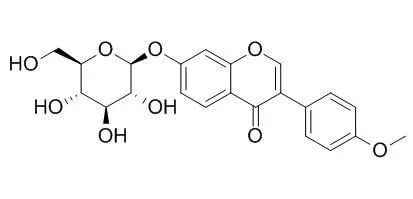| Description: |
Ononin is an additional growth inhibitor in soils associated with the weed, Pluchea lanceolata, it can significantly inhibit root and shoot growth of mustard at 1×10(-4) M, 5×10(-4) M, and 1×10(-3)M , and inhibit the growth of pathogen such as Enterococcus sp., Enterobacter sp. and can promote the growth of probiotics such as Bifidobacteria sp. and Lactobacilli sp. Ononin has weak DPPH·free radical and the superoxide anion free radical scavenging capacity. |
| In vitro: |
| Yao Xue Xue Bao. 2014 Aug;49(8):1162-8. | | The interaction between ononin and human intestinal bacteria[Pubmed: 25322559] |
METHODS AND RESULTS:
The study aims to screen the ability of the bacteria to metabolize Ononin and assess the effect of Ononin on the intestinal bacteria. Fresh human fecal sample was obtained from a healthy volunteer, diluted serially in sterile water and sixty-nine different bacterial colonies were picked out ultimately. UPLC-Q-TOF/MS with automated data analysis software (MetaboLynx) was applied to fast analysis of Ononin metabolites. Furthermore, an E(max) precision microplate reader was employed to determine the growth situation of Enterococcous sp., Enterobacter sp., Lactobacilli sp., and Bifidobacteria sp. Results indicated that hydrogenation, demethylation, hydroxylation and deglycosylation were the major metabolic pathways of Ononin by human intestinal bacteria in vitro. Ononin can inhibit the growth of pathogen such as Enterococcus sp., Enterobacter sp. and can promote the growth of probiotics such as Bifidobacteria sp. and Lactobacilli sp.
CONCLUSIONS:
This study suggested that intestinal bacteria have the metabolic effects of Ononin and the biotransformation was completed by different bacteria. And Ononin can affect the balance of intestinal flora and the degree of influence varies depending on the bacterial species and the concentration of Ononin. | | J Chem Ecol. 1992 May;18(5):713-8. | | Formononetin 7-O-glucoside (ononin), an additional growth inhibitor in soils associated with the weed,Pluchea lanceolata (DC) C.B. Clarke (Asteraceae).[Pubmed: 24253965 ] | | Formononetin 7-O-glucoside (Ononin), an isoflavonoid, was isolated from the soils of cultivated areas associated with the perennial weed,Pluchea lanceolata. Aqueous solutions of this compound inhibited significantly root and shoot growth of mustard at 1×10(-4) M, 5×10(-4) M, and 1×10(-3)M. The level of inhibition was similar to that of hesperidin and taxifolin 3-arabinoside, as reported earlier. The potential allelopathic effect of this compound under field conditions is discussed. | | J. Anhui Agricul. Universit., 2011, 38(2):151-5. | | Free radical scavenging capacities of isoflavonoid glycosides isolated from Pueraria Radix.[Reference: WebLink] |
METHODS AND RESULTS:
Crude total isoflavonoids extracted from Pueraria Radix were partitioned by different organic solvents,then isolated and purified by several column chromatographic techniques and four isoflavonoid gly-cosides were obtained.On basis of the NMR and ESI-MS spectra,these four compounds can be identified as pu-erarin,daidzin,Ononin,and genistin,respectively.Using an organic free radical system of 1,1-diphenyl-2-picrylhydrazyl(DPPH·) and an inorganic free radical system of superoxide anion free radical,the free radical scavenging capacities and antioxidant activities of these four isoflavonoid glycosides were examined in vitro.The results showed that all the four isoflavonoid glycosides were discovered to possess the scavenging capacities of the DPPH·free radical and superoxide anion radical.Meanwhile,there was a significantly positive correlation between the two free radical scavenging capacities and the treated concentrations of the four isoflavonoid gly-cosides.Genistin showed the highest DPPH·free radical scavenging capacity,followed by daidzin and puerarin,and Ononin was the lowest among them.
CONCLUSIONS:
However,the superoxide anion free radical scavenging capacities of the four isoflavonoid glycosides were different from the former.Puerarin was discovered to be the strongest among them,followed by daidzin,genistin and Ononin. |
|






 Cell. 2018 Jan 11;172(1-2):249-261.e12. doi: 10.1016/j.cell.2017.12.019.IF=36.216(2019)
Cell. 2018 Jan 11;172(1-2):249-261.e12. doi: 10.1016/j.cell.2017.12.019.IF=36.216(2019) Cell Metab. 2020 Mar 3;31(3):534-548.e5. doi: 10.1016/j.cmet.2020.01.002.IF=22.415(2019)
Cell Metab. 2020 Mar 3;31(3):534-548.e5. doi: 10.1016/j.cmet.2020.01.002.IF=22.415(2019) Mol Cell. 2017 Nov 16;68(4):673-685.e6. doi: 10.1016/j.molcel.2017.10.022.IF=14.548(2019)
Mol Cell. 2017 Nov 16;68(4):673-685.e6. doi: 10.1016/j.molcel.2017.10.022.IF=14.548(2019)